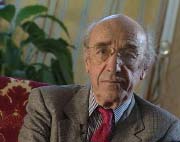 |
 |
Interview
BiographyRoger Guillemin, father of neuroendocrinology, world renowned humanist scientist, and winner of the Nobel Prize in 1977 (with Rosalyn S. Yalow and Andrew V. Schally) for his work on the physiological control of the secretion of the pituitary gland, is now also widely recognised as an artist. Born in Dijon in France on 11 January 1924, he graduated from the medical school in Dijon in 1943 and received the M.D. degree from the Faculté de Médecine of Lyon in 1949, where he worked for about two years in the general anatomy laboratory. While at Lyon he met Hans Selye, an expert on stress, and followed him to Montreal. After completing his thesis in Lyon, he returned to America, where he developed an interest in the history of medicine. He obtained a Ph.D. in physiology in 1953 and joined the staff of the Department of Physiology at the Baylor University College of Medicine in Houston, Texas, where he taught physiology until 1970. He became an American citizen in 1963. He had already begun to collaborate with Andrew V. Schally at Baylor. In 1960 he had briefly returned to France as vice-director of the Endocrinology Laboratory of the Collége de France, but, not satisfied with the way his research was going, he returned to the United States. In 1969, he and his colleagues in Baylor succeeded in isolating the first of the hypothalamic releasing factor, TRF, a result which he himself has described as the fundamental event for the birth of modern neuroendocrinology, an event which signalled the end of the pioneering phase and the beginning of an expanding new science. In 1970 he and his staff accepted the proposal of Jonas Salk, discoverer of the polio vaccine, to transfer to the Laboratories for Neuroendocrinology at the Salk Institute for Biological Studies in La Jolla, near San Diego. In 1982, after being awarded the Nobel Prize (1977), Guillemin and his colleagues identified a new category of molecule called FGF (Fibroblast Growth Factors), a discovery which proved fundamental for the treatment of several diseases of the eye and for diabetic blindness. In 1989 he officially retired as director of the laboratory, although remaining Distinguished Professor of the Salk Institute. |
|
|||
| A long-time collector of art objects, particularly contemporary paintings, pottery and
musical instruments, he gave up his medical research and invented a new style of painting,
"abstract impressionism", and thanks to an original use of the computer, which
he considers an instrument of great creative potential, creates his landscapes, now
exhibited in many major American and European galleries. The computer, which he was
already familiar with from his medical research, has now become for him a new way of
producing and perceiving images, of modifying and expanding the very definition of art and
creating an almost limitless range of effects. Convinced that art is a product and not a process, he stated in a recent interview: "I have no doubt that the works I have produced are art". |
 |
